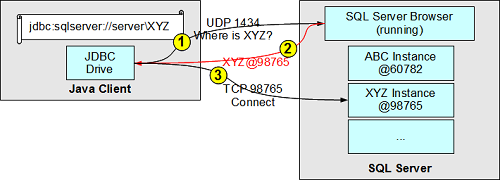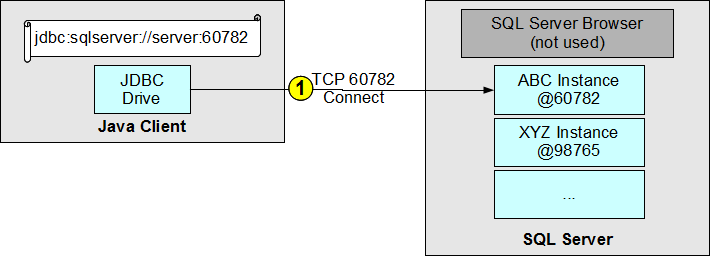JDBC for SQL Server - Herong's Tutorial Examples - v3.14, by Herong Yang
Instance Name Better than Port Number
This section describes how SQL Server support JDBC client applications to use instance name instead of port number to connect to a specific instance.
In the last tutorial, I have resolved the connection issue to my SQLEXPRESS SQL Server instance by turning on TCP/IP support and looking up the port number in the ERRORLOG file of the instance.
But I am not very happy with the solution. Because if the SQL Server decides to a different port number for SQLEXPRESS at next startup time, my application that uses the old port number, 60782, will fail again.
A better solution is to run the SQL Server Browser service together with the SQL Server instance services. This allows client applications to request a connection with the instance name, which will be mapped to the dynamic port number used by the requested instance.
Earlier versions of SQL Server only supports a single database instance on a single host machine. JDBC client applications can connect directly to the database instance at the default port 1433 or a different port the instance is listening at, see the picture below:

Newer versions of SQL Server can support multiple database instance on a single host machine. Each database instance can configured to listen to a different dynamically selected port. This will give JDBC client application a hard time to keep track of which port is used by which instance. So Microsoft introduced the SQL Server Browser service to help by offering a port number look up service with UDP protocol on port 1434.
If you specify an instance name in the connection request, the JDBC Driver is smart to make a UDP call first to the SQL Server Browser with the instance name. The SQL Server Browser will return the port number of the given instance. Then the JDBC Driver will a TCP connection on that port number. see the picture below:

But if you know the port number used by a specific database instance, you can still connect directly to that database instance by specifying the port number in the connection request, see the picture below:

Obviously, using the instance number is a much better than using the port number, because the instance name is less likely to be changed over time.
Table of Contents
JDBC (Java Database Connectivity) Introduction
Microsoft SQL Server Express Edition
►Microsoft JDBC Driver for SQL Server
Installing Microsoft JDBC Driver for SQL Server
Loading Driver Class Automatically
Loading Driver Class with Class.forName()
DriverManager.getConnection() and Connection URL
Enable TCP/IP with SQL Server Configuration Manager
Specifying Port Number in Connection URL
►Instance Name Better than Port Number
Specifying Instance Name in Connection URL
Closing the Database Connection - con.close()
Specifying Database Name in Connection URL
Incorrect Database Name in Connection URL
Creating Connections with DataSource Class
Microsoft JDBC Driver - Query Statements and Result Sets
Microsoft JDBC Driver - DatabaseMetaData Object
Microsoft JDBC Driver - DDL Statements
Microsoft JDBC Driver - DML Statements
SQL Server - PreparedStatement
SQL Server CLOB (Character Large Object) - TEXT
SQL Server BLOB (Binary Large Object) - BLOB
Using Connection Pool with JDBC
JDBC-ODBC Bridge Driver - sun.jdbc.odbc.JdbcOdbcDriver
JDBC-ODBC Bridge Driver - Flat Text Files
JDBC-ODBC Bridge Driver - MS Access